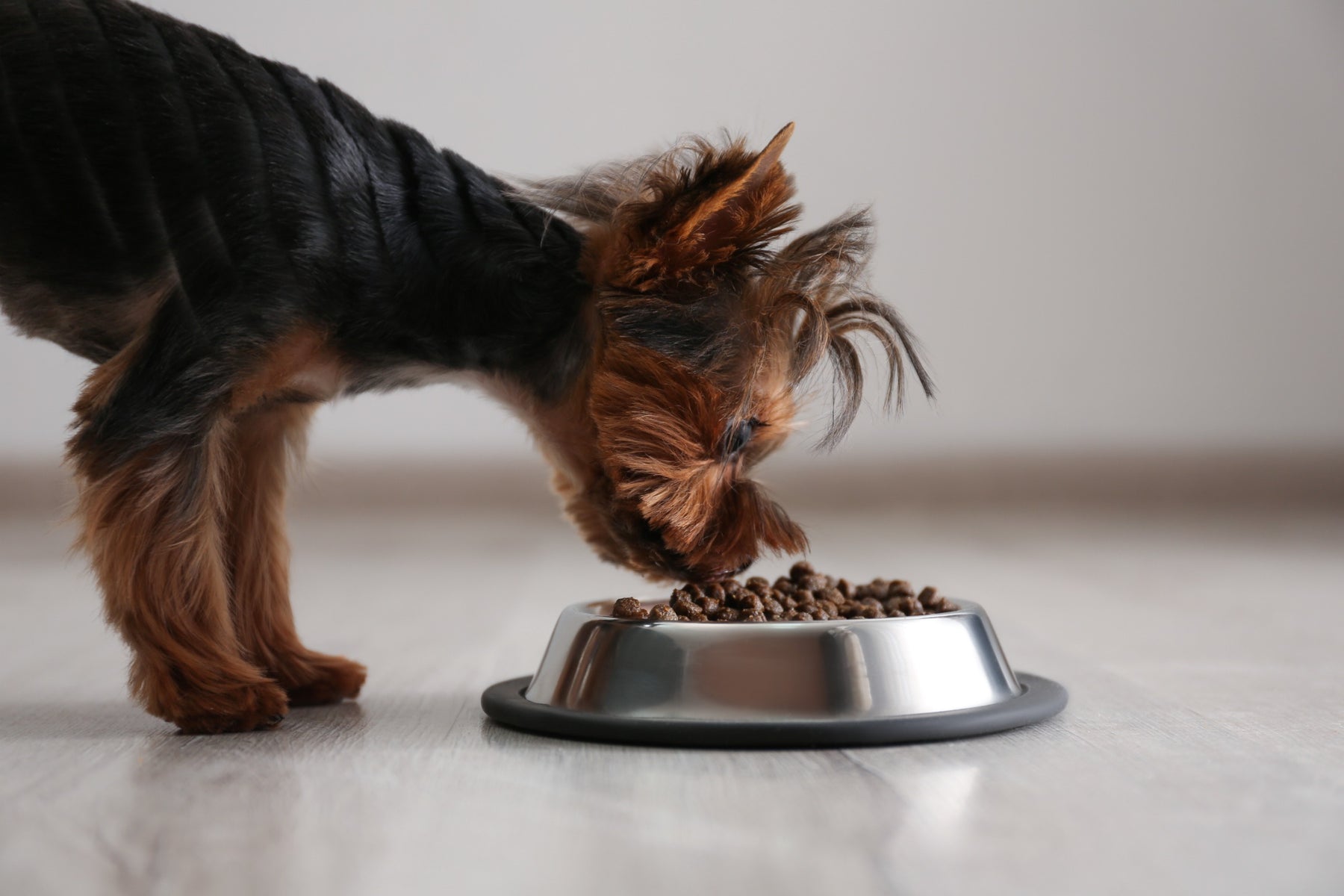
Everything you Need to Know about a Dog Food Topper

Whether you want to entice your picky pup to eat or ensure your senior dog gets an added boost of nutrition at mealtime, dog food toppers such as Wellness CORE Bowl Boosters can be the perfect solution. But what is a dog food topper? And how can pet parents help their dogs get the most out of these mouth-watering mix-ins?
These days, in addition to the classic dog food question — “Wet or dry?” — many people are also wondering about meal toppers for dogs. “That’s because they’re a relatively new innovation in the pet food industry that has quickly gained popularity among pet parents,” explains Dr. Alex Schechter, DVM, founder of Burrwood Veterinary Hospital.
If you’re thinking of offering your dog a food topper, we’ve rounded up everything you need to know — including how to use them, how they can benefit your dog, and expert tips for incorporating yummy toppers into your dog’s diet.
Dog Food Toppers 101
So what, exactly, are dog food toppers?
“Dog food toppers refer to any addition to your dog’s regular, daily dog food,” explains veterinarian Dr. Michael Fleck, DVM, host of The Pet Buzz radio show.
“Toppers can range from simply adding water to your dog’s food, to sophisticated quality combinations of high-level protein, carbohydrates, fats, vitamins, minerals, electrolytes, and essential fatty acids,” he adds.
Toppers for dog food can be wet or dry, cooked or raw, homemade or commercially produced. Some common varieties include:
- Freshly frozen wet food
- Wet food in cans or pouches
- Liquid broths or gravies
- Crunchy toppers
- Freeze-dried toppers
For DIY dog parents, homemade dog food toppers could be as simple as mixing some unsalted bone broth into your dog’s kibble or topping their dinner with a sprinkle of blueberries.
There’s also a wide range of commercial dog food toppers available to suit all kinds of preferences and palates.
Some are strictly complementary foods you can serve in addition to your dog’s regular complete and balanced diet, like shelf-stable Wellness CORE Bowl Boosters. Others can be served as a topper or a complete meal, such as Wellness Bowl Boosters Freshly.
Commercial dog food toppers offer busy pet parents quality and convenience without the hassle of homemade dog food toppers. Plus, they’re subject to the Association of American Feed Control Officials (AAFCO) nutrient profile and labeling standards. So it’s easy to know exactly what you’re getting, as well as whether the formula is nutritionally complete and balanced or meant for intermittent or supplemental feeding only.
5 Reasons to Use a Dog Food Topper
If you’re already feeding your dog food that’s nutritionally “complete and balanced” according to AAFCO, you might wonder if you even need a topper.
However, even dogs whose diet is complete and balanced don’t always look or feel their best. So here are five reasons to consider adding a dog food topper to your pup’s regular rotation.
1. Provide additional nutrition
Quality nutrition is key to good health for all dogs. But that becomes especially important for dogs in poor health due to age or illness. Nutrient-packed dog food toppers offer pet parents an easy way to perk up kibble with a boost of flavor and nutrition.
There are even formulas designed specifically to support immune health, which is essential for both continued well-being and prevention, especially as dogs age.
2. Increase the palatability of your dog’s meals
“Food toppers can be helpful for picky eaters or dogs with dietary restrictions,” says Schechter. “They not only add flavor and variety to a dog’s meal, but they can also help ensure all nutritional needs are met.”
For instance, if your picky dog tends to leave most of their dinner in the bowl, they may be missing out on key vitamins, minerals, nutrients, and calories to fuel their energy needs. Adding a wet topper that contains their favorite ingredients is like a nutritional insurance policy that entices your picky pet to gobble up every last bit of vital nourishment in their bowl.
3. Help boost hydration
Dehydration in dogs can happen for many reasons, ranging from gastrointestinal upset, disease, and heat stroke to simply not drinking enough water. While you always want to make sure your dog gets proper veterinary treatment for any illness, as long as your vet approves, dog food toppers can help dogs stay hydrated.
If dehydration is a concern, look for toppers with a higher-than-average moisture content, like Wellness Bowl Boosters Simply Shreds, a protein-rich formula of meat and broth with a moisture content of 90 percent.
4. Aid digestion
“Dog toppers are a great way to support a healthy diet and good digestion in dogs,” says Schechter. “They come in many options for different needs, like weight management, picky eaters, and sensitive stomachs,” he adds. Wellness even offers a Bowl Boosters formula that’s specifically designed to help support your dog’s digestive health with ingredients like probiotics and fiber-rich fruits and vegetables.
5. Perk up your dog’s meals…safely
It can be tempting to add some table scraps to your dog’s bowl, especially if they’re giving you those puppy dog eyes. But people food, especially foods prepared with oils or spices, can be hazardous to dogs. And some can be downright toxic.
If you want to surprise your dog with some safe toppings for dog food but don’t want to risk gastrointestinal issues, then a commercially-available dog food topping may be your best bet.
Additionally, according to the Wellness dog food brand, these five Signs of Wellbeing indicate good health in dogs:
- Healthy skin and coat
- Optimal energy
- Healthy digestion
- Strong teeth and bones
- Healthy immune system
If you or your veterinarian are concerned your dog is lacking in any of these five areas, adding a dog food topper could provide a number of benefits, especially formulas designed specifically to target key issues, like skin and coat health.
How to Use a Dog Food Topper: Expert Tips
Ready to add a topper to your dog’s diet? Check out our expert tips first, to make sure you’re on the right track.
Schedule a veterinary exam
“If your dog suddenly becomes a picky eater, this may be a sign of dental problems, gastrointestinal issues, or illnesses and infections,” says Schechter. “Before including dog food toppers in the dog’s regular diet, your veterinarian should be consulted,” recommends Fleck. That way, your vet can evaluate whether an underlying medical condition could be contributing to any changes in your dog’s health, appetite, or appearance.
Choose the best type of topper for your dog
Homemade, freeze-dried, fresh, or canned? When it comes to what to add to your dog’s regular food, pet parents face no shortage of options!
When choosing a commercial dog food topper, Fleck suggests spending some time trying out different flavors and styles to see what kind your dog likes best.
If your dog loves the first topper you offer them, great! But it’s a good idea to allow them to try a few different options so you can see what they prefer. Some dogs love the added flavor of shredded meat toppers, while others might benefit from the addition of some healthy vegetables and extra nutrients.
Compare homemade vs commercial
“Choosing between a homemade or commercial food topper for dogs depends on your preferences and your dog’s needs,” says Schechter. “Homemade toppers offer control over ingredients and can be tailored to your dog’s nutritional needs and taste. In contrast, commercial toppers provide a balanced and complete nutritional profile and often include beneficial supplements,” he adds.
According to Fleck, “Veterinarians have been recommending homemade food toppers for dogs to help address pet health conditions since veterinary medicine began.”
“However, homemade toppers generally require extensive effort,” he adds. So commercial dog food toppers that are convenient and readily available may be a better choice if it means you can sustain the benefits long-term.
Introduce the topper gradually
Just as with any new food, make sure to slowly introduce toppers into your dog’s diet.
“A sudden change in diet can cause gastrointestinal problems, including vomiting and diarrhea,” says Schechter.
Pay attention to feeding recommendations
It’s also worth noting that toppers should never be used as a substitute for regular dog food unless they meet AAFCO’s nutrient profile standards for dog food. In these cases, the label should provide feeding instructions that vary, depending on whether you intend to feed as a meal or a topper.
If the topper is for intermittent or supplemental feeding only, don’t forget to take those extra calories into consideration. For overweight dogs, you may need to reduce the amount of kibble to account for the extra calories in toppers.
So, if you’ve been wondering “What can I add to my dog’s food?” dog food toppers are a great solution. Toppers offer dogs a nutritional boost while safely adding new flavors and textures that transform meals from boring to brilliant.
